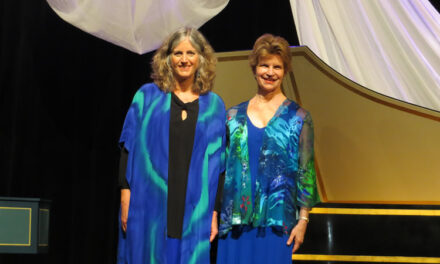The first of two concerts scheduled for this year’s Overtones series at Bösendorfer Hall took place on May 30. Subtitled “The Lyrical Impulse,” it lived out its promise. Most enjoyable lyrical themes culminated in one of my all-time favorites, often heard on WCPE but not on their Top 100 list – the Trio, Op. 49, by Felix Mendelssohn. Its soaring melody ( Molto Allegro agitato ) touched and lifted the soul.
The principal Overtones artists were violinist Brian Reagin and pianist John Ruggero with guest cellist Jonathan Kramer. The community is enriched by this annual series sponsored by Ruggero Piano on Hargrove Road in Raleigh.
Asked if in the future the Overtones concert series might be established as a subsidiary non-profit organization, Deborah Ruggero said that is not currently a part of the plan. At present, it is a professional platform for John Ruggero and his virtuoso colleagues. Wearing another “hat,” as piano pedagogue he departed in haste after the concert to fly to Texas in support of his pupil, Salam Murtada of Mebane, a contestant in the 4th Van Cliburn International Piano Competition for Outstanding Amateurs.
This particular concert was ostensibly a showcase for John Montgomery’s 1708 Stradivarius violin and for Deborah and Richard Ruggero’s Bösendorfer Imperial piano. In his pre-concert commentary, Montgomery paused to also credit the cello maker, Kurt Widenhouse, of Belmont, NC. For this reviewer, the cello made the program. Given the perfection of both the Stradivarius and the Bösendorfer, always dependably controlled by the artists, the two European instruments were upstaged, albeit in genteel ensemble fashion, by the cello built in Charlotte as it soared into the aforementioned eminently recognizable first principal theme of the Mendelssohn Trio that followed the intermission. The theme of its second movement, Andante con moto tranquillo, introduced slowly with intense feeling expressed on the Bösendorfer, was then echoed by the strings. The light-hearted Scherzo’s ending elicited a virtual gasp from the audience although they did not interrupt with applause. The Finale, Allegro assai appassionato, concluded the afternoon quite successfully. With its appassionato statement, the cello gave the violin a run for the money. For me, the cello graciously dominated the program.
As I watched the virtuosi, I marveled that they are indeed the current beaux-arts trio of the Triangle, even though they looked as if they were dressed for a banker’s convention. Comparing them to the famous (capitalized) trio of that name, the music was impeccably synchronized, but there was no apparent ongoing interpersonal communication until the very end of that work, when Kramer graciously nodded to the others.
Taking brief notice of the library card pocket in the front of the piano score as it was opened for performance, I asked Richard and Deborah Ruggero after the concert where the musicians obtain music for concerts. (I was reminded of the Philadelphia Free Public Library’s Fleisher collection of music.) Very quickly, I was told that pianist/composer/pedagogue John Ruggero has his own library, managed with a card file system in order to share it with students. It was suggested that a visit to his studio would be a future feature story possibility in itself. Certainly a personality profile of the pedagogue is due, considering his current involvement with the Cliburn Competition through his student.
Mozart’s Sonata in E Minor, K.304, opened the violin-and-piano segment of the program, and in the Allegro movement, a beautifully clean tone was apparent from the Stradivarius. The two-movement work proceeded to a pensive and somber mood considering the title of the Tempo di Menuetto movement; the composition would provide gracious accompaniment for courtly dancing. There was especially nice ensemble work between the piano and the violin toward the end. Next came Bartók’s “Rumanian Folk Dances.” It was apparent in the first two that even a Strad can squeak if the notes are high…. Earlier, someone had asked when a violin becomes a fiddle and his companion suggested “When it is used for bluegrass.” Although certainly not bluegrass, the sixth dance, “Maruntel” (“Lively Dance”) approximated a fiddle performance, to my delight. The other movements are Staff Dance, Bràul, Stamping Dance, Dance of the Buscum People, and Rumanian Polka. There was excellent contrast in these numbers.
Before intermission, there was a performance of Brahms’ Sonata in A, Op. 100. This melodious work commands repeated future listening, and certainly the afternoon’s performance would be distributable via tape or CD: passionate, clearly articulated work by John Ruggero, at the Bösendorfer, was a perfect foil for showing off the Stradivarius, played by Reagin. The work is full of outstanding romantic melodies, and as the gorgeous piano rippled, low tones on the violin were easily discernable, as Montgomery had predicted in his pre-concert introduction to the instrument. The low notes appeared in contrast to clear, transparent and very beautiful high notes in the work. Cello-like tones on the violin opened the third movement, marked Allegretto grazioso (quasi Andante), and the duo proceeded together to its grand conclusion.











